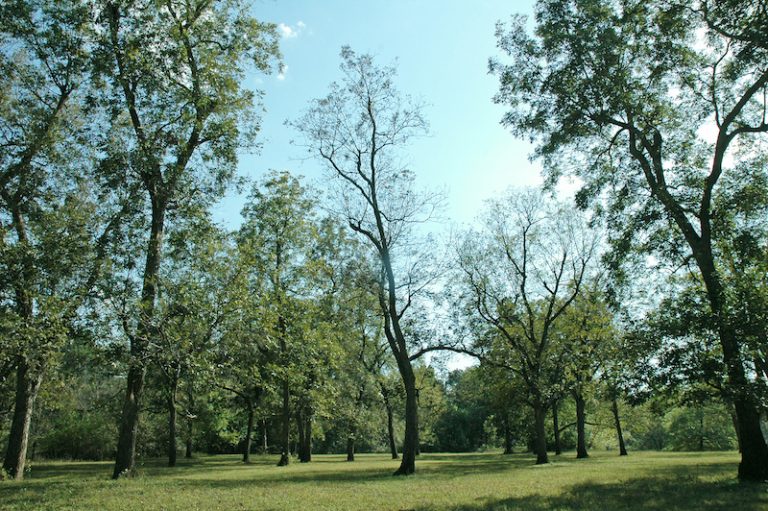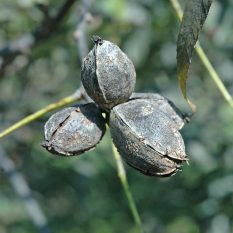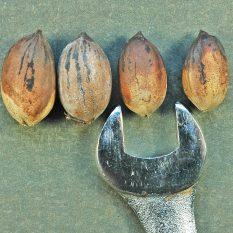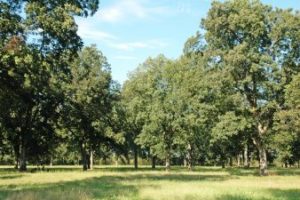
A Short Drive, A Chance to Scout the Native Crop
I was driving along backroads through native pecan groves when I came across a stopped pickup and a guy standing out in the middle of the road with a pair of binoculars trained on the upper branches of nearby trees.
Turns out, I interrupted a pecan buyer trying to get a feel for the nut set in our river bottom. After talking pecans for a bit, I drove away thinking how I look at native pecan groves during the month of October and form my own opinion on grove yield potential.
During mid-October, our native trees are beginning the process of preparing for dormancy. The nuts should be packed with kernel by this time, and all residual plant energy is being stored in roots and twigs for next year’s growth cycle. Ultimately, this storage of plant resources defines a native grove’s long-term productivity. At this time of year, I can look at the foliar health of a native grove and predict not only this year’s crop but the potential for future crops.
While driving down the gravel roads, I stopped at several points to photograph pecan groves. My first stop was at a grove that receives zero annual fertilizer applications and zero fungicide applications. It seems some guys think that all they need to do to raise a crop of pecans is to fly over the trees with a spray plane to apply insecticides for casebearer and weevil control.
But if you look at the photo, you’ll note that several trees are already completely defoliated and those trees have few or no nuts. Early defoliation, in this case, is caused by a combination of nitrogen shortage and leaf disease infections. Even during an “on” year like this season, this grove will struggle to produce 400 lbs. per acre.

This native grove, the second along the backroad tour, is well fertilized but lacks disease control. (Photo by William Reid)
Down the road, I found a grove that receives a higher level of management. The grove is fertilized every year in both fall and spring, and insects are controlled. However, good disease control is missing.
This grove is sprayed by air, and even if a fungicide was included in the spray tank, applying fungicides to native trees with just 2 gallons of water per acre will never provide the coverage needed to prevent disease. The foliage in this grove appears healthier, primarily due to an enhanced level of soil fertility (Figure 2). However, you can still spot trees that have started to defoliate early. This early leaf drop is a good indication that pecan disease was left uncontrolled in this grove.
The one thing you can’t see in the photo is the impact pecan scab can have on native nuts. Scab susceptibility, like all tree attributes, varies widely in a native tree population. The summer of 2017 provided excellent conditions for the spread of pecan scab and the nut crop on some trees might be completely lost.


Scab causes nut losses in two ways. Early scab infections can cause pollinated nuts to drop from the tree. More commonly, scab stunts nut growth resulting in the production of unmarketable small nuts. I took some photos to demonstrate this point. Figure 4 shows a cluster of native pecans completely covered by scab. This kind of damage is usually not noticed by growers until the tree is shaken at harvest and small black nuts fall to the ground (if they shake out at all). So, I harvested this nut cluster and peeled off the shucks to reveal four small nuts. I’ve included a 9/16-inch wrench in the photo to make the point that even if you pick up all the scabby nuts, your cleaning crew will discard every nut (too small for shellers). This grove should average 700 to 800 lbs. per acre of salable pecans.

In contrast to the first two, this native grove is well fertilized and receives regular fungicide treatments through a ground rig. (Photo by William Reid)
The last grove I photographed receives fertilizer twice a year and is sprayed with both insecticides and fungicides with a ground rig. In 2017, the trees received three fungicide applications applied with 100 gallons of water per acre. As you can see, the trees still have healthy foliage in mid-October. This last photo was taken at the Pecan Experiment Field so I have access to 36 years of yield data for these trees. Our trees under a full management program are averaging 1157 lbs. per acre. The 2017 crop looks to be well above this long-term average.
Yes, I realize that fertilizer and pesticides are costly. But, the increase in yield should more than pay for all additional inputs. What you can’t see by looking at photos of native groves is that the combination of fertilizer applications and disease control has the long-term effect of reducing alternate bearing.